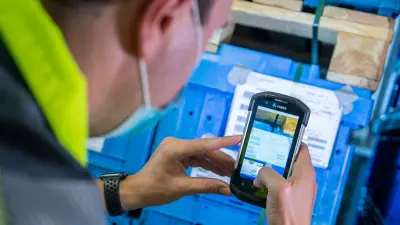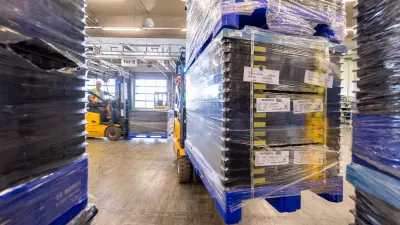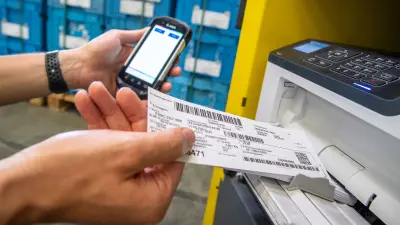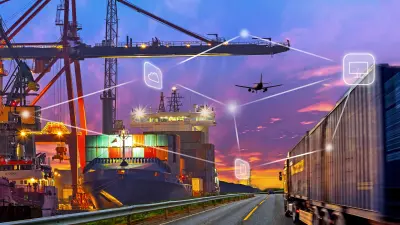Caught in the booking web
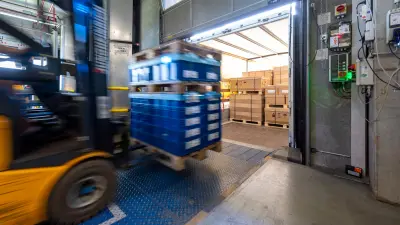
2021-01-14
Automated goods receipt makes work a lot simpler for logistics experts, with savings of up to 30 percent made possible thanks to new processes and cameras. One pioneer in this area is the German Bosch location at Homburg.

Successful pilot project
It was like clockwork. Connection terminated – the annoying error message was part of his everyday life for years. The most important tool, a scanner, regularly refused to work. But the problems did not stop there. Counting crates, poring over delivery notes, comparing data, and later having colleagues type everything in by hand at the office. Day-to-day work was complicated and kept everyone on their feet. The associates sometimes had to walk 250 meters to book a goods receipt. It was these conditions that led the location to launch a pilot project for the introduction of an automated goods receipt.
The countless labels on pallets and crates, all of which had to be scanned by hand, have now been replaced by just one: the “global transport label.” Logistics associates can now use a more modern scanner to capture all the information and book the goods receipt on-site themselves. This is possible because suppliers digitally announce their deliveries and provide comprehensive data. The logistics experts in Homburg now work with a mobile workstation, which is equipped with a computer, a scanner, and a laser printer for internal shipping documents. That allows them to book the goods much faster.
“We can increase productivity in goods receipt by up to 30 percent.”
Fewer inventories
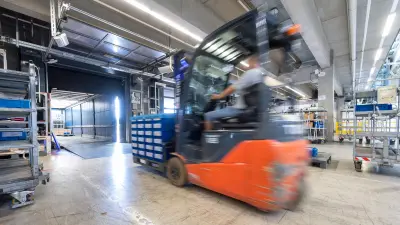
The Bosch plant in Homburg has been able to make a substantial leap in the digitalization and automation rate of incoming goods, raising the level from four to 95 percent. This has drastically shortened the goods receipt process by two-thirds. There are far fewer pallets in the goods receipt area than before and large inventories are no longer an issue. Not only that, but other potential problems have now become much clearer and can therefore be optimized. Since all the data is also now digital, being able to conduct faster analyses opens up the potential for new improvements.
Next, Homburg is planning to digitalize the last five percent of the flow of goods, eliminate shipping documents, and route goods directly to the production lines in each plant section instead of via the local logistics center. That will only work with cross-departmental collaboration and the full backing from corporate headquarters.
This backing comes in the form of experts such as Achim Pfeffer, who is responsible for strategy and the development of automated goods receipt in the Supply Chain Management corporate department at Bosch. “We can increase productivity in goods receipt by up to 30 percent,” he says. That’s why his team wants to introduce the automation concept to all goods receipts at Bosch in the long term. Colleagues from Global Business Services in Stuttgart are behind the on-site implementation, with the two operating units working hand in hand with internal divisions and Bosch IT.
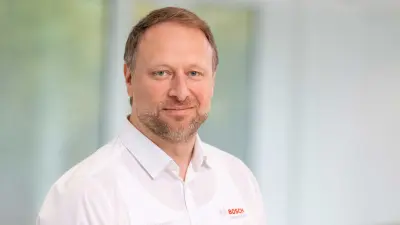

Volker Leder is the head of the automated goods receipt program at Global Business Services and has been involved in the project at the Homburg plant from the very start. “The solution involves much more than just labels,” he says. The improvements range from shipping at the supplier’s premises to the arrival of the goods, unloading, and inspection, right through to storage. However, the detailed delivery notification and the uniform transport labels are the most interesting features. “This is because up until now, over 90 percent of our suppliers have only been sending a simple delivery notification — you cannot automate that,” says Leder. That is also the challenge: Every supplier has to go along with it in order to make it work.
As simple as banking apps
Smart camera technologies might offer another solution for optimizing goods receipt processes. At some Bosch plants, they are already testing how this works. Paper documentation is still the norm in some areas here, too. Associates compare delivery notes with the goods, count crates, and check material numbers.
But that will soon change. In the future, pallets will be photographed with a smartphone and all the data will be automatically captured. The approach follows the lead of banking apps. These allow the user to photograph an invoice, with the data then automatically recorded for a bank transfer. Central Bosch logistics is currently developing a corresponding app.
Achim Pfeffer outlines the advantages that this offers: “We can imitate the human eye with a camera and thereby capture much more data than with a scanner. The smart cameras not only read bar codes but also text. This means deliveries can be recorded and a wide range of standards complied with.” The solution should soon be ready and available for Bosch plants, and perhaps even for the external market. “The bottom line is that the automated goods receipt will make us significantly more competitive. We can handle goods receipts with fewer associates and create capacity for other tasks.”
“The working world in logistics is undergoing rapid change. Associates will increasingly become supply chain managers in the goods receipt of the future.”
Multiple fields of application
In the future, Bosch logistics plans on testing a similar solution in shipping. In addition, preparations are underway for the testing of permanently installed cameras in another plant, which will automatically record every goods receipt without the associates needing to do anything. “The working world in logistics is undergoing rapid change. Associates will increasingly become supply chain managers in the goods receipt of the future,” Leder predicts. They will then mainly be dealing with malfunctions and deviations while machines handle the bookings.
These are enormous changes awaiting colleagues in plant logistics at Bosch worldwide. Many of the associates were uncertain at first. In the meantime, however, the advantages outweigh the disadvantages. “Industry 4.0 will change a lot,” says Pfeffer, and advises optimism. “You have to trust in the future.”
Profile

Achim Pfeffer and Volker Leder
Achim Pfeffer has been head of material flow since 2018 and is responsible for the development of automated goods receipt for Supply Chain Management at Bosch. Following his studies in business administration with a focus on logistics, he began his career as section head for logistics at Bosch Rexroth.
Volker Leder is head of the automated goods receipt program in the Global Business Services operating unit at Bosch. He has been with the company since 2008 and has already held various positions in Germany and abroad. Leder studied business administration with a focus on purchasing and logistics.


